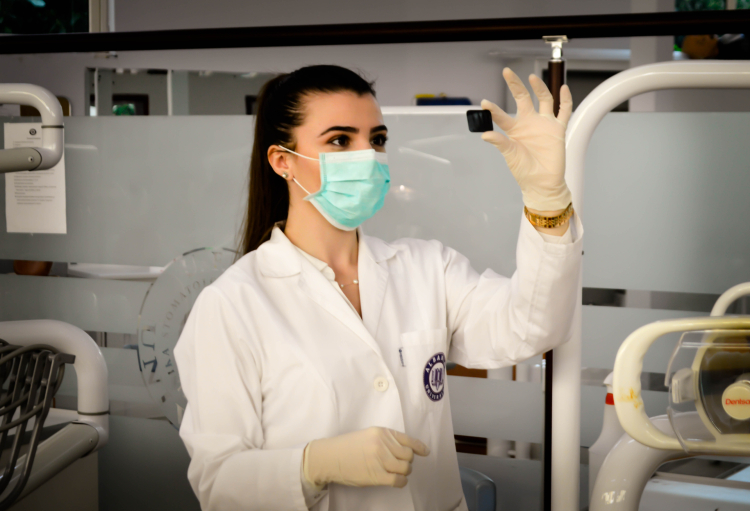Healthcare workers around the world are at the forefront of saving lives during this global pandemic. Every day we read of spontaneous outbursts of applause, news reports, and social media posts communicating enormous gratitude towards medical professionals risking their lives on a daily basis so that others may receive treatment.
The facts & figures in the healthcare sector
Overwhelmingly, those professionals are women. A 2019 report by the WHO analysing data from 104 countries concluded that seven out of ten employees in the global health workforce are women. This week, Dr. Helen Fidler of the British Medical Association confirmed that 75% of workers in the UK’s National Health Service are female. While every active health professional is aware that his or her life is at risk from a potentially fatal viral infection, the women who make up this workforce are at significantly greater risk than the men. This is because the Personal Protective Equipment (PPE) issued to NHS healthcare workers is designed to a male body standard.
When PPE doesn’t fit properly, it’s no longer protective equipment.
The issue of significantly higher risks to women’s safety because of the implicit assumption that men are the standard is not new. A cross-industry study of 5,000 women who wear PPE at work found that less than one-third have equipment specifically tailored to their size and gender. A recent study by Swedish transport researchers of European Union practices established that women remain significantly more at risk of fatality from car crashes because safety assessments use test dummies based on men’s dimensions. A further recent study found that women are 50% more likely to die from a heart attack due to misdiagnosis because the symptoms they experience are different from standard male symptoms, on which most medical training is still based.
Is the media industry any better?
The implicit assumption that men are the normative and women are the deviation remains pervasive in our media, our communications, and our thought patterns. An analysis of the top 100 grossing films of 2014 and 2015 using an automated detection tool determined that male characters received twice as much screen time, and twice as much speaking time as female characters. A similar study of over 11,000 speaking roles in PG-rated family films, cartoons and US primetime TV programs found that the proportion of female characters depicted as having a job was only half that of women’s actual participation in the labour force.
How does our thought process work?
It’s important to clarify that the assumption of male as standard is often unconscious in the minds of people who might even be horrified to discover they harbor such assumptions. Further, women and men are almost equally likely to think this way. Harvard’s Mahzarin Banaji has used the Implicit Assumption Test to determine that a majority of people of both genders make automatic associations between ‘men’ and ‘career’ (compared to ‘women’ and ‘career’), and in my research work, both male and female participants readily associated a deliberately non-gendered CEO with personality characteristics they perceived as masculine.
Our implicit assumptions are of great significance because they shape our expectation of what is usual and normal. Moreover, they can be remarkably resistant to an objective reality that is virtually the contrary to that in the underlying assumption, as is seen in the case of PPE designed for British healthcare workers. In Hans Rosling’s final book Factfulness, he noted that many of our implicit assumptions about society appear to be stuck in the 1970s and don’t reflect current realities.
Do your part to fix gender inequality
Given that the assumption of male as standard is both prevalent and unconscious, if you’re not actively working to rule out this assumption then you’re likely to be perpetrating and perpetuating it. As a business school professor, educator or presenter there are at least three easy steps you can take to prevent yourself from communicating this ‘male as protagonist’ or ‘male as standard’ perspective.
- Review your teaching material to check for equal representation of gender in the images, cases and examples you use
- Having determined, for example, that you have an equal number of pictures of professional men and women in your slide deck, now review those images for differences in roles. For example, do your images portray women as students or participants, while all professors or team leaders are represented by men?
- If you use humour in your classes, review the choices you make. Do your jokes contain the commonly found format of ‘a doctor and his wife’?
In summary, our predisposition to view men as the normative and women as the deviation is not just a distorted view of the world, it’s actively putting women’s lives at risk in daily activities from driving a car to executing their professional roles. The average healthcare worker at the forefront of this crisis is a woman—and statistically, those most likely to be admitted to hospital are men.
References
Banaji, M. R., & Greenwald, A. G. (2016). Blindspot: Hidden biases of good people. Bantam.
Boniol, M., McIsaac, M., Xu, L., Wuliji, T., Diallo, K., & Campbell, J. (2019). Gender equity in the health workforce: analysis of 104 countries (No. WHO/HIS/HWF/Gender/WP1/2019.1). World Health Organization.
Geena Davis Inclusion Quotient (n.d.) The Reel Truth: Women Aren’t Seen or Heard. Retrieved from: https://seejane.org/research-informs-empowers/data/#C
Health and Safety Magazine (1st June 2017). UK study shows less than one-third of women workers have properly fitting PPE. Retrieved from: https://www.safetyandhealthmagazine.com/articles/15757-uk-study-shows-less-than-one-third-of-women-workers-have-properly-fitting-ppe
Linder, A., & Svensson, M. (2019). Road Safety: The average male as a norm in occupant crash safety assessment. Interdisciplinary Science Reviews, 44 (2), 140–153.
Wilkinson C, Bebb O, Dondo TB, et al. (2019). Sex differences in quality indicator attainment for myocardial infarction: a nationwide cohort study. Heart 105: 516-523.



